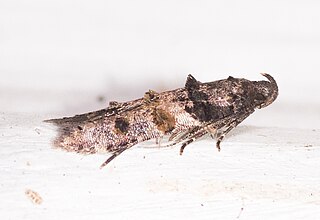Related Research Articles
Sorhagenia is a genus of moths in the family Cosmopterigidae. The name honours Ludwig Friedrich Sorhagen.
Perimede circitor is a moth in the family Cosmopterigidae. It was described by Ronald W. Hodges in 1969. It is found in North America, where it has been recorded from Arkansas, Illinois and Ontario.
Perimede erema is a moth in the family Cosmopterigidae. It was described by Ronald W. Hodges in 1969. It is found in North America, where it has been recorded from Arkansas and Illinois.
Perimede maniola is a moth in the family Cosmopterigidae. It was described by Ronald W. Hodges in 1969. It is found in North America, where it has been recorded from Illinois.
Perimede parilis is a moth in the family Cosmopterigidae. It was described by Ronald W. Hodges in 1969. It is found in North America, where it has been recorded from Arkansas and Illinois.
Periploca devia is a moth in the family Cosmopterigidae. It was described by Ronald W. Hodges in 1969. It is found in North America, where it has been recorded from Arizona to California.
Periploca dipapha is a moth in the family Cosmopterigidae. It was described by Ronald W. Hodges in 1969. It is found in North America, where it has been recorded from Arizona and Texas.
Periploca hortatrix is a moth in the family Cosmopterigidae. It was described by Ronald W. Hodges in 1969. It is found in North America, where it has been recorded from Arkansas, Illinois and Indiana.
Periploca hostiata is a moth in the family Cosmopterigidae. It was described by Ronald W. Hodges in 1969. It is found in North America, where it has been recorded in Washington, California and Arizona.
Periploca labes is a moth in the family Cosmopterigidae. It was described by Ronald W. Hodges in 1969. It is found in North America, where it has been recorded from Arizona.
Periploca opinatrix is a moth in the family Cosmopterigidae. It was described by Ronald W. Hodges in 1969. It is found in North America, where it has been recorded from Wyoming.
Siskiwitia alticolans is a moth in the family Cosmopterigidae. It was described by Ronald W. Hodges in 1969. It is found in North America, where it has been recorded from Arizona and Texas.
Sorhagenia baucidis is a moth in the family Cosmopterigidae. It was described by Ronald W. Hodges in 1969. It is found in North America, where it has been recorded from Illinois and Saskatchewan.
Sorhagenia cracens is a moth in the family Cosmopterigidae. It was described by Ronald W. Hodges in 1978. It is found in North America, where it has been recorded from Idaho.
Sorhagenia daedala is a moth in the family Cosmopterigidae. It was described by Ronald W. Hodges in 1964. It is found in North America, where it has been recorded from California.
Stilbosis placatrix is a moth in the family Cosmopterigidae. It was described by Ronald W. Hodges in 1969. It is found in North America, where it has been recorded from Arkansas, Maryland and Illinois.

Walshia miscecolorella, the sweetclover root borer moth, is a moth in the family Cosmopterigidae. It was described by Vactor Tousey Chambers in 1875. It is found in North America, where it has been recorded from southern Canada south to Florida and Texas.
Neodactylota basilica is a moth of the family Gelechiidae. It was described by Ronald W. Hodges in 1966. It is found in North America, where it has been recorded from Arizona.
Neodactylota liguritrix is a moth of the family Gelechiidae. It was described by Ronald W. Hodges in 1966. It is found in North America, where it has been recorded from Louisiana, Mississippi and Texas.
Prolita thaliae is a moth of the family Gelechiidae. It was described by Ronald W. Hodges in 1966. It is found in North America, where it has been recorded from California, Colorado, Utah and Wyoming.
References
- ↑ Savela, Markku. "Sorhagenia pexa Hodges, 1969". Lepidoptera and Some Other Life Forms. Retrieved January 18, 2019.
- ↑ "420343.00 – 1637 – Sorhagenia pexa – Hodges, 1969". North American Moth Photographers Group. Mississippi State University. Retrieved January 18, 2019.
- ↑ Hodges, Ronald W. (1969). "Nearctic Walshiidae: Notes and New Taxa (Lepidoptera: Gelechioidea)" (PDF). Smithsonian Contributions to Zoology (18).
- Pitkin, Brian & Jenkins, Paul. "Search results Family: Arctiidae". Butterflies and Moths of the World. Natural History Museum, London.
| This article relating to Chrysopeleiinae is a stub. You can help Wikipedia by expanding it. |